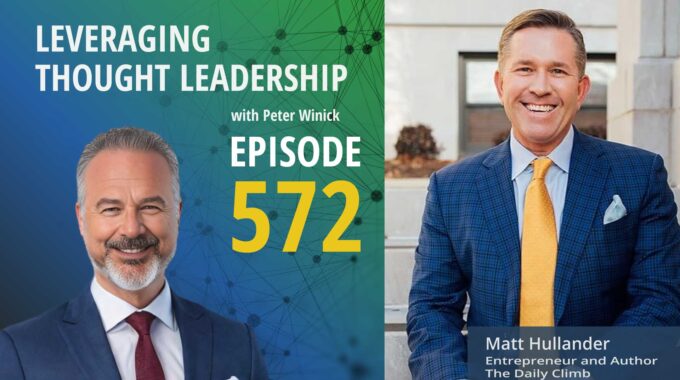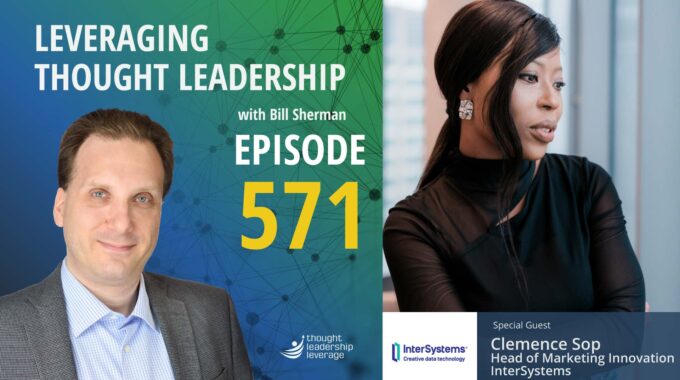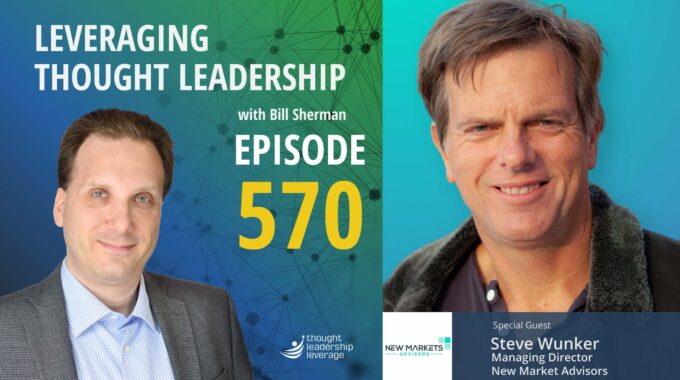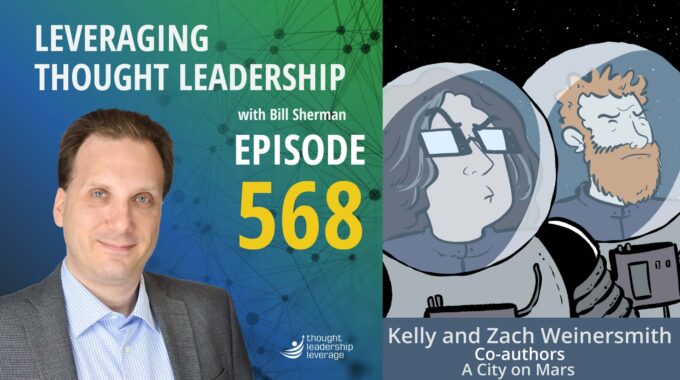Expanding Horizons: From Home Improvement to Thought Leadership A conversation with Matt Hullander about being…
Creating Your Own Path to Leadership | Tony Martignetti
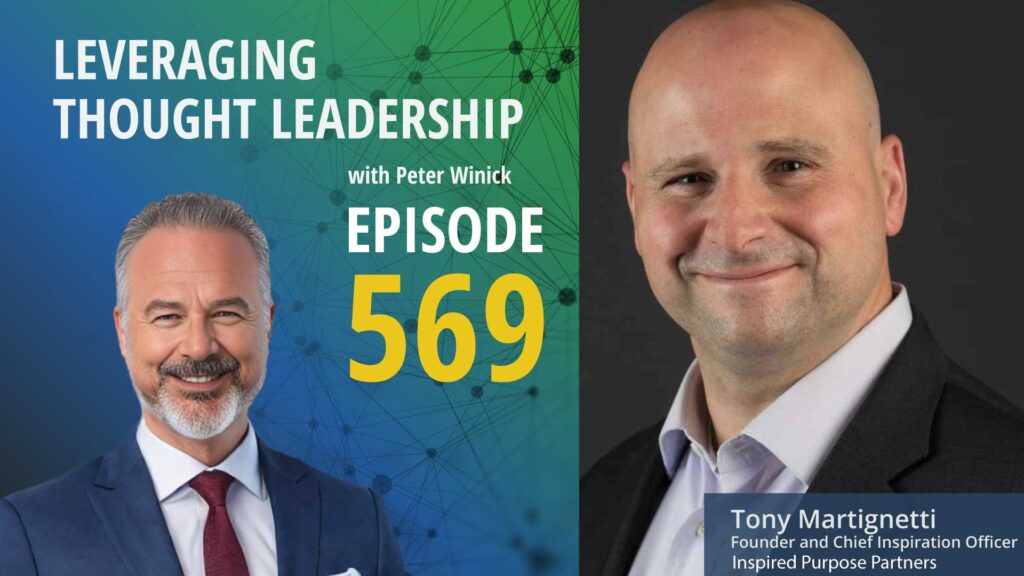
Expanding Vision, Narrowing Focus
A conversation with Tony Martignetti about finding his passion and expanding his impact through thought leadership.
In this episode of “Leveraging Thought Leadership,” host Peter Winick sits down with Tony Martignetti, Founder and Chief Inspiration Officer at Inspired Purpose Partners, author of Climbing the Right Mountain: Navigating the Journey to An Inspired Life and host of the Virtual Campfire podcast. Tony shares his journey into the world of thought leadership, which began not from a clear plan, but through a series of life shifts that revealed a deeper passion for guiding leaders in chaotic times.
Tony describes how his path transitioned from finance and strategy roles in biotech to thought leadership and executive coaching. Despite success in his previous careers, he felt something was missing. Growing up, Tony had a creative side, known for his art, but societal expectations pushed him toward pre-med and then business. The discomfort of being in the wrong field led him to re-evaluate his career, ultimately deciding to forge his own path. He emphasizes the importance of creating your own place when you don’t fit in elsewhere, using curiosity and exploration to discover where you belong.
His approach to finding his niche combined a balance of passion, skill, and market demand. Tony introduces his guiding philosophy, “Expand your vision, narrow your focus,” encouraging exploration before narrowing down on a specific area to serve. By having “curiosity conversations,” he was able to understand the problems and pain points of others, leading him to his current role as an executive coach for tech leaders.
Tony’s clients are typically in the tech industry, where his unique perspective aligns well with innovative thinkers. He helps chief technology officers, chief science officers, and chief strategy
officers communicate their technical ideas to a broader audience and break down silos within their organizations. Through his work, he facilitates better communication among teams and creates a collaborative environment for leaders.
While most of his work requires being physically present with his clients, Tony is considering productizing some aspects of his coaching to offer more scalable solutions in the future. He acknowledges the challenge many thought leaders face with marketing and sales and shares his three-part strategy to overcome it: “Affiliate, Associate, Collaborate.” This approach involves partnering with other experts, engaging in professional groups, and collaborating with others to
create greater impact.
Overall, this episode delves into Tony’s journey from a traditional career path to becoming a thought leader in the tech industry. It highlights his insights into building connections, fostering communication, and navigating the challenges of a rapidly changing world.
Three Key Takeaways:
- Forge Your Own Path: Tony Martignetti’s journey illustrates that career paths are not always linear. He transitioned from finance and strategy roles in biotech to thought leadership in tech, emphasizing that sometimes you need to create the place where you belong rather than trying to fit into predefined roles. He encourages people to use curiosity and exploration to find their unique path.
- Expand Your Vision: Narrow Your Focus: Tony’s guiding philosophy underscores the importance of exploring a wide range of possibilities before honing in on a specific niche. This approach allows for a broader understanding of where one can make the most impact before concentrating efforts on a particular area. Through “curiosity conversations,” he was able to understand others’ needs and pain points, guiding him to his current role as an executive coach for tech leaders.
- Affiliate, Associate, Collaborate: Tony shares his strategy for overcoming the marketing and sales challenges that many thought leaders face. This three-part approach involves affiliating with other experts to offer comprehensive solutions, associating with professional groups for personal and business development, and collaborating with others to create greater impact. These steps highlight the importance of building relationships and leveraging a network to succeed in thought leadership.
Transcript
Peter Winick And welcome, welcome, welcome. This is Peter Winick. I’m the founder and CEO at Thought Leadership Leverage. And you’re joining us on the podcast today, which is leveraging thought leadership. Today my guest is Tony Martignetti. He is a recognized LinkedIn top voice in leadership development, organizational development, change management, executive coaching and speaking his I don’t know if you’d call it a tagline, but his core thing is keeping leaders helping leaders stay grounded in chaotic times. I’d argue times are always chaotic, depending on how you look at that. You know, he’s a podcast host, he’s an author, he’s been recognized by thinkers 360 and he’s lowered his standards to join me today for about 20 minutes. So thanks, Tony.
Tony Martignetti Oh, I love joining you. This is great. I appreciate the, the opportunity to be here with you today. Thank you.
Peter Winick Yeah. So tell me a little bit about the journey of Tony, right. Because there’s certain professions where it’s, hey, I want to be X, so therefore I’m going to do Y. However, in the sort of leadership world, most people then never wake up one day and say, I’d like to be a thought leader and therefore I’m going to do that. So how have a how did you get here?
Tony Martignetti Yeah, sometimes you’re thrust into this world and not necessarily, you know, kind of, driving on this path. You know, I came to this from a place of working in industry for about 25 years, working in biotech, particularly working in finance and strategy roles and realizing that I wasn’t doing what I was meant for. And so it’s a long time to be working in a field and then realizing, gosh, there’s something missing. There’s something that’s.
Peter Winick Done. What does that mean? Not meant for, is it? Getting the job done, doing a decent job, but going home? Going? I’ve kind of not like what was the point of that?
Tony Martignetti Well, yeah, there was a missing piece, you know, so. And, let me kind of go even further back to say that when I was growing up, I was an artist. I was known for drawing and painting and doing a lot of work that was more artistic in nature. And then I decided to go pre-med, which because that made sense, because, you know, a lot of people in my life said, you better find a job that’s going to, like, serve your family, you know, provide for your family.
Peter Winick So my last cardiologist was an impressionist. So that obviously makes sense.
Tony Martignetti Of course, it’s a good combination nowadays because now there’s a thought about like how art and in medicine, they actually are the good bedfellows. So yeah, you know that’s a tangent for another day. But I decided to go pre-med and then switched from pre-med into business because I realized that that wasn’t for me. So I felt like a lost way finder all of my life. This feeling of like, okay, like this is good and I’m good at it. But I realized that there was still something always that was searching for.
Peter Winick Sustained me for a minute, because I think that, you know, on the one hand, one might say, well, that’s a weird path artist pre-med business. Like, okay, those three usually not on the same menu, but I’ve heard not the exact story. Similar pieces where, like, I kind of fit here, and I got a little bit of this, and I love improv, but I’m also a, an engineer. Like things that like, once you sort of look at the totality of the person and they say, well, I don’t fit here and I don’t fit here and I don’t fit there. So you got to kind of create your own path. And that’s where either entrepreneurship, thought leadership, the combination of the two, because, you know, I imagine you had a great career on the business side, but probably like, as you said, wasn’t hitting all the notes for you. 
Tony Martignetti Yeah. And this comes back to this place of like, well, if you don’t know where you belong, sometimes you to create the place where you belong. And I think that’s where, you start to thrust yourself into a place of, well, I may have to forge my own path to brand to myself, to borrow a little bit of a Brené Brown.
Peter Winick Hey. That scary. It takes a lot to give away the steady paycheck and insurance and all that sort of fun stuff. And then the other piece that I’ve seen, and I’d love to hear your take on this, is a lot of thought leaders say, okay, great. So here’s the path that I’m going to take, right? So I’m going to go this way, whatever. But they do it a little bit to sheltered, myopic whatever, because there has to be that intersection of what am I really great at? What would jazz me? And oh, by the way, would anybody pay me for this story? Yeah, yeah, yeah. So how did you how did you like, thread that needle? Because that’s really hard.
Tony Martignetti Yeah. I think first of all, and this comes back to a model I often tell people about, it is about expand your vision, narrow your focus. You know, I had to curate and think about like the things that I that do like me up and that is about exploration and curating and thinking about the things that really do make me come alive. You can’t go in and focus and say, I’m going to do X for Y and do it this way. I had to first get expansive and say, okay, what’s possible first, right before narrowing down and saying, this is who I’m going to serve and how I had what.
Peter Winick Was part of that getting to what is possible for you, testing the marketplace, because that’s where I was going before. I think sometimes what happens is thought leaders might be a little bit introverted, introspective, like, you know, they spend all this time thinking, thinking, thinking, thinking, and then they’re going to road test it versus sort of the classic entrepreneurial mindset is ready firearm versus ready. Aim, aim at a name. You know.
Tony Martignetti One of my favorite things to tell people about this is curiosity conversations, which, you know, this is something that Brian Grazer talks about in his especially the curious mind but curious curiosity conversations are these conversations where you just don’t come in with this, this is what we’re going to do, but it’s more about exploring and figuring out, well, what are some things that are on your mind? What are the things that are your problems, your pain points? And so I think that’s what led me to the path of figuring out what I wanted to do is just talking to more people. So conversations unlocked a lot of the things that I did. It wasn’t through just introspection.
Peter Winick Let’s fast forward. So, you know, in the introduction, there are a lot of things that you’ve got, right? I’m an author, I’m a podcaster, I’m a keynote speaker on and on and on. Yeah. Tell me as if I’m a seven year old, which some might argue, who pays you to do what?
Tony Martignetti Yeah. So the people who pay me are usually tech leaders, people who are in the innovative space, who want me to come in and help them to become more clear and more impactful in the work that they do.
Peter Winick So stop there for a second, because when you give me your background. Yeah. Are we had pre-med. We had business. Right. But now tech is the place that values what you have to bring to the table. And it’s not because you’re the founder of a tech company or you’re a coder or whatever. So that’s like, how did you land on tech? Because I wouldn’t have guessed that.
Tony Martignetti Yeah. The reason the way I landed on that is because these are people who think differently, like me. I think very differently, and I have a very expansive view. But what often happens is when you think differently, the first reaction people have is that, oh, this is too out there. This is too different. And people don’t necessarily want to hear it. So you have to find ways to connect with that audience. And that might mean how can I bottle this up, create ways of connecting with other audiences and make sure that connect with the people who have to execute on the things that I’m doing.
Peter Winick Now, did you have to kiss a bunch of frogs in terms of other industries before you landed on tech?
Tony Martignetti Oh, absolutely. And I still I still to this day spend time on, in tangential industries. I’ve, I’ve done work with Warner Brothers and, you know, with insurance agencies and things like that, which are fun. And I think that I learn a lot through that. But ultimately, tech is what I realize, this this is the area that I most enjoy. And these are the people who get the most value from me.
Peter Winick Got it. So we just heard the word insurance agency and fun in the last sentence. I don’t remember the last time that’s happened, but I’m doing so. So you landed on tech and what? What’s the what are they paying you for? What’s the before and after? What are they hoping to achieve by working with you?
Tony Martignetti Yeah. First of all, there’s a lot of frustration and, feeling this like they’re just not being heard and feeling like there’s more to be done and that they’re not really getting through their voice heard in the room. So a lot of when.
Peter Winick You they where. So I want I want to double so they yeah implies a certain level and who’s the they were typically did that.
Tony Martignetti Usually their chief technology officers chief science officers or chief strategy officers, which I know is not a common thing you hear. But they’re definitely in that space of people who are, you know, dealing with technical issues and they’re having to voice them to a broader audience. And there’s people on their team that they also engage in this, process.
Peter Winick So I love the laser focus there. And then the way that you help them is what a combination of coaching advice like what’s the ways that you support that client base. Because I love that we went from tech to know chief tech like, you know, laser focused, who the folks are. And I think, you know, a lot of thought leaders come from the school of, well, so many people can benefit from what I have in every. And it’s like, no, no, no, no, no, no. Because now the next time a CTO calls you, you have incredible credibility. You can say, I’ve worked with funny people just like you in these type of situations and without having to say it out loud, it’s therefore I’m your I’m your guy. Like there’s this is a no brainer versus if one day it’s a CTO and one day it’s, you know, I don’t know, a creative director at an ad agency or an ad agency and, you know, like on and on. So give me a sense of the sort of the types of problems that you’re solving for them.
Tony Martignetti Yeah. I mean, one of the, the biggest challenges I just recently started to work with is this idea of breaking down silos in their functions. And, you know, there’s, a lot of challenges of dealing with different teams trying to do different things. And how do you get people talking together. And so I kind of see myself as the person who breaks down the, the, the barriers and, in terms of communication between groups. But it starts with that leader coming to me and saying, hey, I know there’s more we can do, and I know there’s more we can impact in this organization by really getting people talking together. And, and I need your help to come in and help me facilitate that process. Okay. So I’ll come in as an advisor and a coach as what you said earlier, it’s not just coaching, it’s advising to and working with the team as well to the extent that that’s what’s needed.
Peter Winick If you’re enjoying this episode of Leveraging Thought Leadership, please make sure to subscribe. If you’d like to help spread the word about our podcast, please leave a five-star review at ratethispodcast.com/ltl and share it with your friends. We’re available on Apple Podcast and on all major listening apps as well as at thought leadership leverage.com/podcast. And how much of the work that you do requires Tony to be in the room, or the zoom versus derivatives of your thinking and thought leadership that could be licensed or productized?
Tony Martignetti I love it. I love the way you think, Peter. You know most of it, Eric, right now at this point, is a lot of in the room and being and engage with the team, which I think is good because, you know, by me being there with them, it allows me to see the interactions and ensuring that the teams are together and creating that space for connection. I think that’s really important. But as time goes on, you know, I do want to find ways to productize that to an extent that allows them to say, here’s the structure, here’s the process. You can follow this, this, path.
Peter Winick Got it. Got it. And I want to touch a little bit on the place, at least from my experience where most thought leaders, authors, advisers, coaches, consultants struggle the most. And that’s on the sales, marketing, business development and doing the work. Like, if I were to magically just pick you up and say, oh, tomorrow morning at two, here’s the CTO is having this problem, blah, blah, blah. You can knock that out of the park, right? Yeah, but the whole part about finding clients and marketing and positioning, I don’t know, lots of thought leaders, like that’s where they show. That’s where they struggle. That’s where they have a tough time. How do you wrestle with that?
Tony Martignetti Yeah, I was just writing an article about this, and, it’s something that I, I struggle with, but that’s why I wrote an article about it, because, you know, you have to write what you don’t know.
Peter Winick Well, there’s a piece I’m about to do on. It’s not a self-help book, but it was a book that helped me, like, why did someone write the book? They do. So I love the idea that you’re writing an article on something that you’re struggling with, you might have out there, as well as thought leadership. But anyway, go back to the question. Yeah.
Tony Martignetti So first of all, it’s about, I call it affiliate associate. Sorry.
Peter Winick General article. And you’ll get back to me on the Thursday.
Tony Martignetti Exactly. I’m still working on it.
Peter Winick Generate only two thirds of it.
Tony Martignetti Obviously they’re all eighths. But I think that the key thing here. So when it comes to affiliate, I mean, first of all, knowing that, oh, collaborate was the word I couldn’t think of. Okay, so affiliate comes down to this, this idea that, like, we have to find other people who are doing they have skill sets and expertise and bring them to the table. The more we can refer the people. Yeah. Human resources, then that becomes a, you know, a golden tool to bring into other businesses. So I, I’m a curator of experts, I like to say. And yeah, by doing so, that becomes like a great way for me to enter an organization and say, hey, I have a person for that. I have a guy, I have a girl for that.
Peter Winick That’s the technical term in New York we use for that. It’s called got a guy, right?
Tony Martignetti Yeah. Exactly right. Associate is figuring out what groups are you part of that are actually going to help you to unlock not only your own, you know, the network that’s going to, to give you referrals, get you the business you need to, but also your learning and your, professional and personal development to keep you on your edge. And this is hard because a lot of groups out there can be really crappy. So you have to go through a lot of, you know, kissing, kissing some toads before you get to the frog and then the collaborate. I think highly of this, this quote, which is, you know, the amateurs compete and professionals create. So when you collaborate with others, it’s about finding ways that two people coming together can collaborate and make something even bigger together.
Peter Winick Let him love it. And I think the other sort of thread to that, that I would add, is the mistake that lots of thought leaders make, at least early on, is okay. I don’t like the marketing and sales thing, but I’ll do it a little bit. Then I get some crack down really, really busy so I don’t have to do it right. And then the projects dry up as they inevitably do. And then you come up for air and your PNL looks like, you know, the EKG of a cardiac victim, right? Like you have to constantly do it. And the amount of marketing and thought leadership that you’re putting out in the world shouldn’t be an inverse to how busy you are. It needs to be done even when you don’t need it today, because we always need it. So how do you how do you respond to that?
Tony Martignetti Yeah, I mean, I won’t say that I’ve, I’ve completely figured it out, but I think that’s one of those things that we need to, from time to time, step away and say, okay, where am I balancing my load? Where am I keep creating that that sense of okay connection to what’s going on next? I came from a finance background. So yeah, I realized that there is a sense of like looking ahead and planning for the future. Yeah, knowing that if I don’t spend time on those things, then I will be in trouble. I, you know, there’s a sense of planning for the next while also living in the current.
Peter Winick And I think some of that requires tools and other things to make sure that the thing the content is getting out there in the thought leadership is getting out there, and those marketing things are happening regardless of, you know, just, Tony, have a busy day or like day to day.
Tony Martignetti Exactly. Which, you know, I didn’t mention the last of the of the things that I was going to say, which was generate generating content. I think it’s so important to continue to generate content that plant seeds for the future and consistently doing it.
Peter Winick Yeah, 100%.
Tony Martignetti Because those are the things that also can plant seeds for future, opportunities.
Peter Winick When I like what you said earlier in that, yeah, I was struggling with that. So I decided to write an article about it. Right. So I love this idea of, you know, we’re all lazy, but we don’t have to keep things in separate buckets. You could conflate content development with business development. You can create, you know, connect it with something that you’re struggling with. It doesn’t need to be, you know, I’m spending two hours a. Creating great thought leadership. Then a different two hours on business about like I would look at all the different things that you have to do and say, how can I connect the dots here? Right? And if I’m struggling with this issue, others might and it might be an opportunity to relationship build. Let me reach out to some folks and get some quotes for the article. Like I love that that way of thinking as well. Tony.
Tony Martignetti There’s two words that come to mind when I think about what you just shared, and it actually is something that drives me a lot. Is connection and leverage, right? Yeah, leverage is really about finding ways to do more with less, not more to make more impact with less. And that might mean taking two things and doing them at the same time, because they create more of an impact by doing them together. You know, writing an article that actually solves a problem for you, or collaborating with somebody else on something that is going to drive the needle in your business. And connection is a very, very big part of this. I’ve recently started to see connection as like, we need to connect some people who we haven’t talked to in a long time and say, like, where am I not really close out or connect with people who I need to talk to? I’ve recently been talking some people who I went to my MBA program with, like, you know, 20 years ago or so, and I found that that’s actually something that I felt bad about, but also it has been fruitful. You know, we’ve been having some great conversations and saying like, how are we going to work together?
Peter Winick Well, and I think that’s interesting is that people tend to think of different phases of their lives as different chapters, as isolated. So now, you know, I love you thinking like, wait, my MBA cohorts, do they know what I’m doing today? And how could they be of help me? Because even though we had this, this relationship might be 20 years ago, whatever I could sparked that. Chances are someone that was getting an MBA 20 years ago, 20 years later, might be someone that you’d want to be of interest. Whether you, you know, you lost touch. And usually we lose touch with people not because we don’t like them anymore. Care about, you know, just life happens right in life. So having the courage to reconnect and say, hey, I’d love to update, you know, tell you what I’m doing. Cool. Well, as we start to wrap anything, you know, you’ve been at this quite some time now. What would you say to someone that is in the situation you’re in, you know, whatever. When you started down the thought leadership journey some years ago, ten years ago or something, what would you tell them in terms of advice?
Tony Martignetti Yeah. First of all, have more conversations. Talk to more people. And even the people who like just getting out and having conversations with people who you wouldn’t normally expect open up a door to to new learning. If you go in with an open mind, you might find that they have connections that would be create momentum for you the most unexpected places. And I’ll just share one thing that I learned early on. Some of the most unreachable people are reachable. You just have to have the courage to say, hey, you know I’m fast. My what? I’m fascinated by what you do, and I would love to see what I could learn from you.
Peter Winick I think that’s totally true. People think some, you know, some of the folks they follow, some of the followers. Oh, my. They you know, they’re in the stratosphere. They love their stuff. So if you reach out to them in a really thoughtful way, they tend to be fairly generous. Most or a couple jerks out there, right? But they tend to be really good and generous and want to engage in that intellectual sparring and great conversation. So I love that. And that feels better for most people than, oh, I’ve got to put my salesman hat on today. I’d love to have conversations around a topic with an expert in that domain. So this has been great. Tony, I appreciate your time and appreciate you. And, thank you for joining us today.
Tony Martignetti Thank you so much. It’s been a lot of fun.
Peter Winick To learn more about Thought leadership Leverage, please visit our website at ThoughtLeadershipLeverage.com to reach me directly. Feel free to email me at Peter at ThoughtLeadershipLeverage.com, and please subscribe to Leveraging Thought Leadership on iTunes or your favorite podcast app to get your weekly episode automatically.


